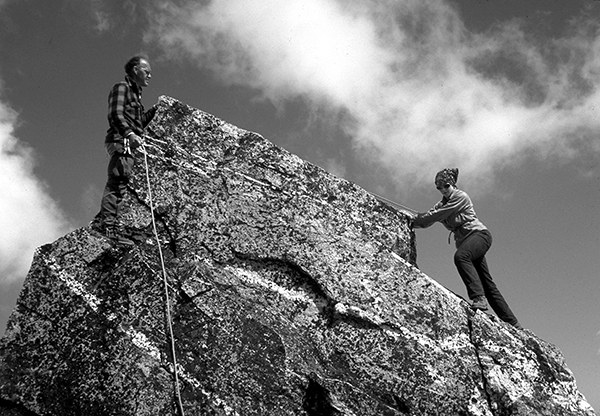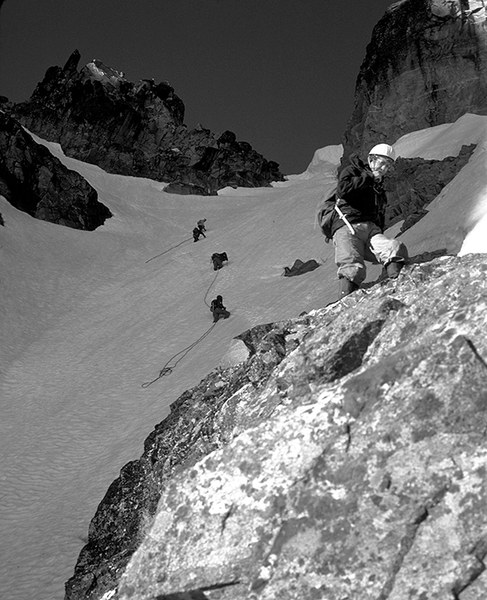
As staff liaison to the Everett branch, I have the opportunity to attend their branch banquet to witness the pride of accomplishment, honor exceptional volunteers, and to be inspired by their always entertaining featured speaker. This year, Lowell Skoog, a distinguished climber, skier, writer, photographer, and Mountaineers historian, gave a presentation on the past and future of Northwest mountaineering.
To learn more about Joe and Joan Fiery, Mountaineers that Lowell referenced in his stories, I pulled out The Mountaineers: A History and searched the web. Not surprisingly, I came across the most comprehensive article of the Fierys on Lowell’s online Northwest Mountaineering Journal. While the entire piece was fascinating, I was drawn to the mountaineering goals they pursued with their eldest daughter, Carla. Below is an excerpt from Lowell’s The Indefatigable Fierys: Exploratory Mountaineers of the Cascades and Coast Mountains:
Mountaineering is largely a sport for the young and unattached. College and the early years of a career, before family responsibilities grow, are the most active and adventurous times in a typical climber’s life. Marriage doesn’t change things much, but the arrival of children does. Many fathers (and a few mothers) are able to climb intensively with the support of a stay-at-home spouse. But married couples with young children rarely continue adventurous climbing together. To pursue exploratory mountaineering from youth through child-rearing until retirement - and to do it as a couple - is almost unheard of. In the North Cascades and British Columbia Coast Mountains, no one has managed this feat quite like Joe and Joan Fiery.
Early Years
Born in October 1918, Joe Fiery started life in Roundup, Montana. His family moved to Seattle around the time of the stock market crash in 1929. Joe graduated from Roosevelt High School in 1936 and earned a mechanical engineering degree from the University of Washington in 1940.
Joe was in the Boy Scouts for a short time where he met friends who were interested in hiking and climbing. They had no instruction. “We learned the hard way, or the blundering way,” recalled Joe, “how to do things and also how not to do things.”
Students didn’t have cars during the Great Depression so getting to the Cascades to climb was difficult. But by taking street cars and ferries, they could get from their homes in Seattle to the east side of the Olympic Mountains.
In college, Joe’s friend Ray Longtin was able to borrow his father’s car, so they climbed in the Cascades more often, especially peaks around Snoqualmie Pass and as far east as the Teanaway River. They also climbed most of the Cascade volcanoes and then the North Cascades in the years that followed. After moving to San Francisco to take a job, Joe joined the Sierra Club and climbed several of the classic, moderate Yosemite climbs of the 1940s such as the Cathedral Rocks, Washington Column, and Royal Arches. With snow and ice climbing experience gained in the Northwest and rock climbing skills honed in the Sierras, Joe developed into a solid, all-round mountaineer.
Joe met Joan Wilshire through the Sierra Club and they married in 1950. Born in August 1928, Joan was a physical therapist and budding artist. She thoroughly shared Joe’s enthusiasm for mountains and climbing. Joe and Joan eventually had three children. In the latter part of 1954, the family moved to Seattle, where Joe took a job as a professor of mechanical engineering at the University of Washington, retiring in 1981.
Joe and Joan joined The Mountaineers after moving to Seattle and they immediately began doing weekend climbing trips in the Cascades. The Fiery name made its debut in Cascade history in 1955, with a first ascent of Columbia Peak’s North Ridge. In the early 1960s, the Fierys began their long association with the Picket Range, widely regarded as the most spectacular and rugged region in the Cascade Range.
Climbing and Family
Joe and Joan introduced their children to the mountains early. In the summer of 1952, when their daughter Carla was just a couple months old, the family traveled from California for a camping trip near Cascade Pass. Joe wanted Joan to see the North Cascades, so they hiked with baby Carla to the Sahale Glacier one day and to a viewpoint high on Magic Mountain another day.
Family pictures show Joe feeding Carla with a baby bottle among the glaciers and moraines of the North Cascades. As the kids grew older, their parents took them skiing in the winter and did a family trip to the beach or mountains each summer.
When the kids became teenagers, Joe and Joan tried to get them interested in mountaineering, both for its own sake and as a way to keep them out of trouble. The effort yielded mixed results.
Carla, who became the most enthusiastic climber of her siblings, recalled the 1969 McAllister Creek traverse: “I don’t know why I went, because it made us a group of five instead of four. I think I was sort of an add-on,” she said.
“No, I think we were hoping to get you out,” Joe remembered fondly.
North Cascade high routes
When Carla was 13 years old, Joan took her on a day climb of Pinnacle Peak in the Tatoosh Range. A year later, Joe took her up The Tooth near Snoqualmie Pass. After that, her parents said she needed to take The Mountaineers climbing course. Joe and Joan continued doing ambitious trips that were beyond Carla’s ability at the time. Carla completed the Basic and Intermediate climbing courses when she was 15 and 16. In the summer of 1969, following her junior year in high school, Carla was invited on her first big trip.
The plan was to traverse from Colonial Peak to Eldorado Peak. This cross-country route had never been traveled before and it offered the prospect of first ascents in the Austera Towers NE of Eldorado. In two days of good weather, Joe, Joan and Carla, with Dave Knudson and Frank deSaussure, traveled to the head of Neve Glacier and climbed Snowfield Peak and The Needle. Fog and rain caught them for several days and white-out navigation was required to descend into the “McAllister Hole,” the deep cirque beneath the icefalls of McAllister Glacier.
 Joan Fiery descends from McMillan Cirque, completing the Elephant Butte High Route and Bowling Alley Traverse in the North Cascades in 1974. She was among the women climbers who left their mark around the world and was a member of the all-woman expedition that successfully climbed Annapurna in 1978. Photo by Dave Knudson, courtesy of the Fiery family.
Joan Fiery descends from McMillan Cirque, completing the Elephant Butte High Route and Bowling Alley Traverse in the North Cascades in 1974. She was among the women climbers who left their mark around the world and was a member of the all-woman expedition that successfully climbed Annapurna in 1978. Photo by Dave Knudson, courtesy of the Fiery family.
“We were so cold we had to build a fire at lunch just to get warm enough to be comfortable,” recalled Carla. They scrambled up a frightfully steep and unstable moraine to the divide near Austera Peak, first climbed by Joe, Joan, John and Irene Meulemans, and Tony Hovey, four years earlier. Good weather returned just in time to tackle the Austera Towers. “I think we climbed every single one of them practically, didn’t we?” asked Carla. “Yeah, we bombed that whole ridge,” laughed Joe. Remarkably, their original plan was to continue to Park Creek Pass via Moraine Lake and the Forbidden and Boston Glaciers. But time lost due to bad weather nixed that part of the trip. From their camp next to Klawatti Peak, they retrieved a food cache at the base of Eldorado Peak, which Joe recalled was “a welcome restoration of our ability to continue eating.” Eventually they descended to the Cascade River and caught a ride back to their cars at Colonial Creek campground.
The following summer Joan, Carla, Dave Knudson and Peter Renz completed the Goodell Creek horseshoe, another pioneering traverse.
Although extremely strenuous, these wilderness traverses offered everything that the Fierys enjoyed in mountaineering. Carla recalled, “There is no question that Joe, in particular, also Joan, and the people who went with them liked to go to places where other people hadn’t been, or if they had been there at least there wouldn’t be any of them around at the time. It wasn’t like climbing in Yosemite or the Bugaboos or even Waddington more recently where a lot of people go there, or even Everest. That’s not the kind of climbing… they were interested in what I always call ‘exploratory’… and in many cases it was, but a lot of times they were places where they had good maps.”
Joe recalled simply: “It was the idea that you could get up in the alpine, you know, and traverse along and bag peaks and camp, and bag peaks and camp… It makes a nice trip.”
The Fiery name probably appears in more North Cascades summit registers than any other name, save Fred Beckey’s. Seeking out high routes in the Cascades and Canada’s Coast Range, Joe and his wife Joan, along with daughter Carla, amassed numerous first ascents.
This article originally appeared in our Winter 2017 issue of Mountaineer Magazine. To view the original article in magazine form and read more stories from our publication, click here.
 Mary Hsue
Mary Hsue

